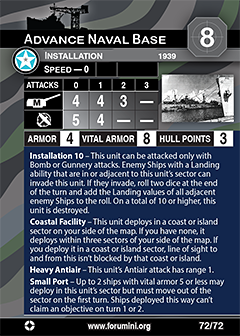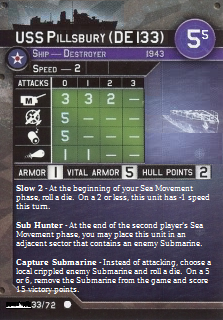Post by mnnorthstars on Apr 14, 2020 5:40:54 GMT
Preamble
The purpose of this card set is to release cards for the rest of the destroyer classes not yet represented in War at Sea and also to have some more famous destroyers in the game, like O'Bannon and Arashi. Here are 72 new destroyer cards! This is also the debut of the half-point for card costing. Although I have gotten in on several card projects before, I have never made cards start to finish. As such, some of these may be way off stat-wise and I would welcome constructive criticism. Let me know what you think!

HMAS Quiberon and the rest of Force Q sank an entire Italian convoy in December 1942, and Quiberon fired on the destroyer Lupo at the end of the engagement.

HMCS Fraser helped evacuate Allied personnel from the Continent in June 1940, and the same month she suffered a fatal collision with the cruiser HMS Calcutta.
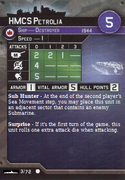
HMCS Petrolia was an updated version of the Flower-class corvettes that gave convoy service to the Allies late in the war.
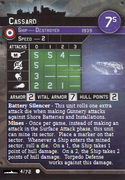
On the day the Wehrmacht entered Paris, Cassard escorted the cruisers Algerie and Foch on a mission to shell the Italian port of Vado Ligure, then she spent the rest of her war in port at Toulon.
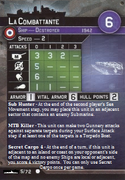
Originally HMS Haldon, La Combattante did what Hunt-class destroyers did best (escort, engaging U-boats, engaging E-boats) and provided shore support for Operation Neptune before landing General De Gaulle, his staff, and gold to fund the new government.

La Melpomene was under French, British, Dutch, and Free French control during the war.
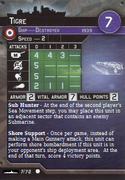
Tigre was captured by the Germans at Toulon, but before and after that she gave noble service to France in convoy duty, fleet action, and shore support.
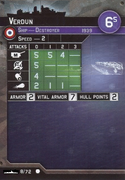
Verdun was part of a class of six ships with similar histories: except for one of her sisters, all of them were scuttled or captured at Toulon in November 1942.

Volta escaped from the Battle of Mers-El-Kebir to the safety of the harbor of Toulon where she remained until the scuttling of the fleet in November 1942.

Condouriotis served in the Royal Hellenic Navy until a want of Italian spare parts (she was Italian-built) and a repurposing of her crew to a more modern ship permanently beached her in 1943.
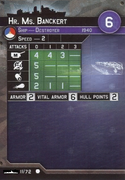
Banckert helped defend Sumatra against Japanese invasion and paid for it with her life; after sinking, she was used as a partially repaired Patrol Boat 106 by the IJN.
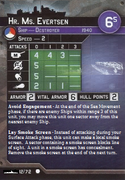
Evertsen arrived too late to the Battle of Sunda Strait to help save cruisers Houston and Perth, so she twice expertly disengaged from two Japanese destroyers before being taken out of action by shellfire.
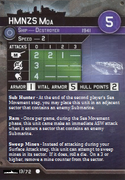
Moa and her sister ship Kiwi famously rammed and sank Japanese submarine I-1 in January 1943.
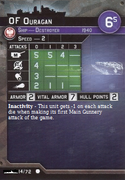
This ship spent most of a year in the Polish Navy as OF ("French ship") Ouragan manned by a crew ported over from ORP Grom after that destroyer sank at the Battle of Narvik.
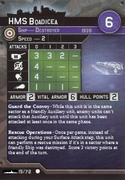
Boadicea twice rescued hundreds of survivors from torpedoed transports and was as busy as many of her sisters, the workhorses of the British fleet in both convoy duty and combat during the war.
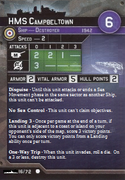
HMS Campbeltown lived three lives: once, she was the Wickes-class USS Buchanan; later she was the British and Dutch Destroyer Campbeltown; but most famously she was the ship that rammed and destroyed the St. Nazaire docks, rendering inoperable the only dry dock that could service Tirpitz.
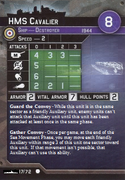
HMS Cavalier famously shepherded a scattered convoy that had fled from U-boat and bomber attacks and was further separated by a violent storm.
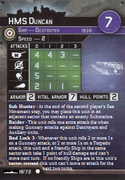
HMS Duncan suffered two collisions during WWII with friendly vessels but otherwise distinguished herself well, capturing a Vichy French convoy on New Year's Day 1941 and participating in the sinking of many U-boats either alone or in concert with other destroyers and aircraft.
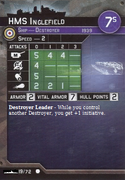
The RN's last purpose-built flotilla leader, Inglefield was within a few miles of both Bismarck and Tirpitz during a career in and near European waters.
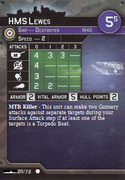
HMS Lewes was USS Craven until the Destroyers for Bases agreement transferred her to the RN; on 9 and 10 November the ship fought off German E-boats attacking her convoy.
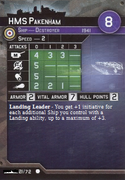
HMS Pakenham helped lead the invasion force that took Diego Suarez, Madagascar from the French and later led several Malta convoys, some successful and some unsuccessful.

HMS Quadrant escorted convoys in three oceans and took part in carrier operations in the British Pacific Fleet; after the war she was transferred to the RAN in exchange for an N-class destroyer.
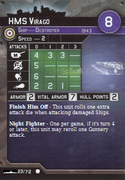
HMS Virago participated in the sinking of Scharnhorst at the Battle of the North Cape and Haguro at the Battle of the Malacca Strait alongside HMS Saumarez, both of them taking place at night.
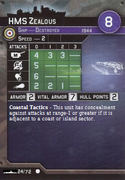
In another life HMS Zealous was the first to be sunk by a ship-to-ship missile; in British service she rescued some 500 Norwegians hiding in caves from German patrols in icy northern Norway.

Ingham was the only Coast Guard cutter to receive two Presidential Unit citations and escorted 27 convoys across the stormy, icy North Atlantic.
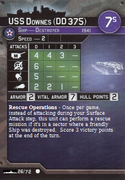
Downes was damaged beyond repair in the Pearl Harbor attack but pieces of the ship were used to build a destroyer that supported operations at Wotje Atoll, the Marianas islands, and Iwo Jima.

Knox was a radar picket destroyer of Task Force 38 in the closing days of the war.
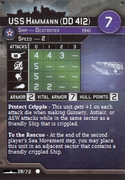
Hammann picked up survivors from the doomed carriers Lexington and Yorktown, including Captain Elliott Buckmaster, before being torpedoed at Midway.
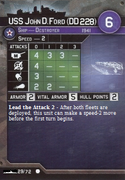
John D. Ford often found trouble as an integral part of the thin line of Allied resistance trying to hold the Dutch East Indies.
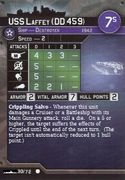
The first USS Laffey was lost at the Naval Battle of Guadalcanal, but not before wounding Admiral Abe and killing his chief of staff aboard Hiei.
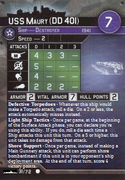
Maury's 16 battle stars and Presidential Unit Citation serve as testament to her long war, usually alongside carriers like Enterprise.
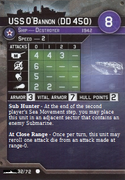
O'Bannon was the first Fletcher to make it to the fight, engaged Hiei at close range, downed many aircraft at all stages of the war, used potatoes to help sink a Japanese submarine, and had the privilege of escorting USS Missouri into Tokyo Bay as the most decorated US destroyer of WWII.

Pillsbury famously captured U-505 with the help of Task Group 28.12.
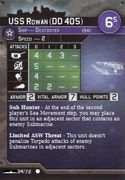
Rowan had the harrowing assignment of guarding convoy PQ 17 to the Soviet Union.
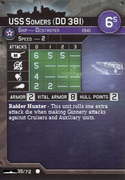
Somers made a career in the Atlantic detaining blockade runners, earning the last USN prize money ever handed out.
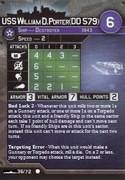
The one that tried to kill President Roosevelt.

Derzkiy has the unique distinction of serving in 4 Allied navies during the war and the Soviets benefited from the British installation of an ASW hedgehog.
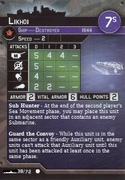
The Romanian destroyer Regele Ferdinand was surrendered to the Soviet Union and entered the Black Sea Fleet in October 1944.
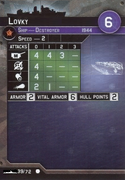
Romania had to surrender its destroyer Marasti to the Soviet Union, but the ship was returned about a year later with the conclusion of hostilities.
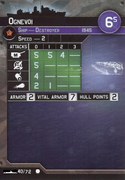
First approved in 1939, the Ognevoi-class design was to be a step forward in all aspects of Soviet Destroyer design; however, only one was completed during the war and that was done using guns taken from the destroyer Tashkent.
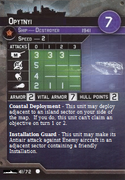
Opytnyi was a failed attempt at making an effective native Soviet destroyer design but did defend the city at the Battle of Leningrad.

1940-type torpedo boats would have been upgraded versions of the 1939 type boats, which would have been called destroyers in any other navy.

Former French destroyer Bombarde spent a year and a summer in German Mediterranean service.
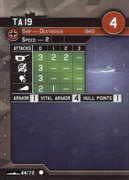
Calatafimi was captured by Germany in September 1943, renamed TA 19, and sunk by Greek submarine Pipinos in August 1944.
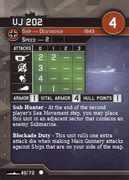
U-Boot Jäger 202 was an Italian Gabbiano-class corvette, Melpómene, that met its end at the Ambush off Pag Island in November 1944 at the hands of two British Hunt-class destroyers that also destroyed two other ex-Italian small craft, while suffering no losses on their side.

Z 4 laid in wait to intercept Allied convoys headed across the Arctic to the Soviet Union.
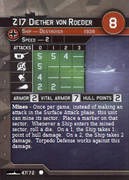
When damaged and trapped in Narvik harbor, Z 17 fought like a cornered wolf before running out of ammunition.
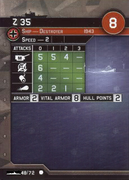
Z 35 struck a mine while laying mines herself in the Baltic Sea off Estonia and sank.

ZH1 was what the Netherlands had started as Gerard Callenburgh; she escorted Japanese sub I-129 into Lorient before her bow was blown off at the Battle of Ushant.

Riboty was built as a WWI scout cruiser but rebuilt as a convoy escort in 1938, finding her way into Soviet hands as reparations after the war.

Captured Yugoslav destroyer Beograd was commissioned into the RM in August 1941 and completed more than 100 convoy missions before being captured by the Germans in Venice nearly two years later.

Ciclone shot down 3 Beaufort bombers and a Beaufighter while on convoy duty in August 1942.
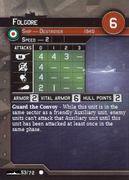
Force Q caught up with Folgore's convoy off of Skerki Bank in December 1942 and the destroyer was sunk in its defense.
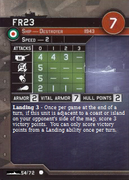
French destroyer Tigre was captured at Toulon in November 1942 by the Germans and given to Italy to serve for a few months with the RM; they in turn gave the ship to the Free French.
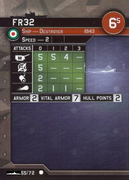
Italy repaired the French destroyer Le Sirocco as FR32 after she was scuttled with the fleet; they scuttled her a final time in Genoa in 1943.
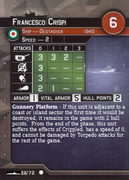
Crispi landed troops to counter British encroachment into the Dodecanese Islands in February 1941 and fired on HMS Jaguar so effectively that the entire British force broke off the engagement.
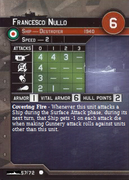
Nullo was on point for the Attack on Convoy BN 7 and as such she took almost all the shellfire and was the only casualty on the Italian side during the abortive fight.
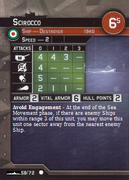
Scirocco and the rest of the attackers at the Second Battle of Sirte found a large British smoke screen separating them from the target convoy until the Italians chose to break off before nightfall, letting aircraft destroy the convoy in the days that followed.

Strale rammed and sank the sub HMS Odin in June 1940.

When Arashi steamed to rejoin the Kido Butai after depth-charging USS Nautilus, her wake was an arrow that pointed American Dauntlesses to the Midway carrier fleet.
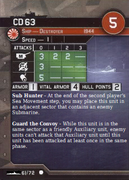
CD-63 and other escorts sank the sub USS Bonefish in June 1945 at Toyama Bay.
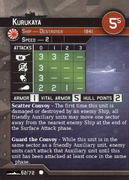
Kurukaya set a record with 54 convoys successfully escorted in her career from Japan to far-flung destinations like Palau, the Dutch East Indies, Singapore, and many points in between.

Rear Admiral Tanaka’s destroyer flotilla sank or damaged all four heavy cruisers at Tassafaronga before withdrawing against the larger US battle group.
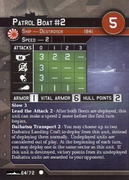
First named Nadakaze, in December 1943 the ship became the designated support ship for the IJNLF based out of Balikpapan, Borneo.
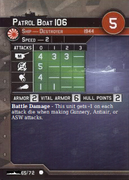
Former Dutch destroyer Hr. Ms. Banckert was sunk and raised but not fully repaired by the Japanese.
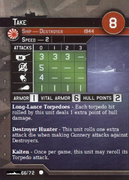
Take carried Kaiten manned torpedoes and survived the war, ending up in British hands.
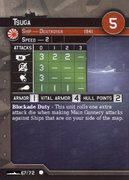
Tsuga spent the war near Chinese waters and supported the invasion of Hong Kong in December 1941.
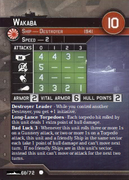
Wakaba collided with friendly ships twice in 1943.
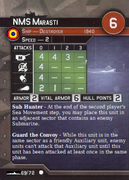
Marasti turned around a Soviet attack on the port of Constanta in between convoy escort missions; during the war her convoys were attacked 10 times and only lost a total of 2 transport ships.
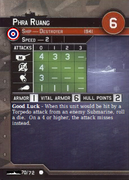
WWI British destroyer HMS Radiant was purchased into the Royal Thai Navy in 1920.

Ceuta and her sister Melilla were workhorses of the Armada franquista during the Civil War.

Marte was aggressively used against Republican foes as well as neutral ships inclined to help the opposing side, like the British steamer Stanbrook.
The purpose of this card set is to release cards for the rest of the destroyer classes not yet represented in War at Sea and also to have some more famous destroyers in the game, like O'Bannon and Arashi. Here are 72 new destroyer cards! This is also the debut of the half-point for card costing. Although I have gotten in on several card projects before, I have never made cards start to finish. As such, some of these may be way off stat-wise and I would welcome constructive criticism. Let me know what you think!

HMAS Quiberon and the rest of Force Q sank an entire Italian convoy in December 1942, and Quiberon fired on the destroyer Lupo at the end of the engagement.

HMCS Fraser helped evacuate Allied personnel from the Continent in June 1940, and the same month she suffered a fatal collision with the cruiser HMS Calcutta.

HMCS Petrolia was an updated version of the Flower-class corvettes that gave convoy service to the Allies late in the war.

On the day the Wehrmacht entered Paris, Cassard escorted the cruisers Algerie and Foch on a mission to shell the Italian port of Vado Ligure, then she spent the rest of her war in port at Toulon.

Originally HMS Haldon, La Combattante did what Hunt-class destroyers did best (escort, engaging U-boats, engaging E-boats) and provided shore support for Operation Neptune before landing General De Gaulle, his staff, and gold to fund the new government.

La Melpomene was under French, British, Dutch, and Free French control during the war.

Tigre was captured by the Germans at Toulon, but before and after that she gave noble service to France in convoy duty, fleet action, and shore support.

Verdun was part of a class of six ships with similar histories: except for one of her sisters, all of them were scuttled or captured at Toulon in November 1942.

Volta escaped from the Battle of Mers-El-Kebir to the safety of the harbor of Toulon where she remained until the scuttling of the fleet in November 1942.

Condouriotis served in the Royal Hellenic Navy until a want of Italian spare parts (she was Italian-built) and a repurposing of her crew to a more modern ship permanently beached her in 1943.

Banckert helped defend Sumatra against Japanese invasion and paid for it with her life; after sinking, she was used as a partially repaired Patrol Boat 106 by the IJN.

Evertsen arrived too late to the Battle of Sunda Strait to help save cruisers Houston and Perth, so she twice expertly disengaged from two Japanese destroyers before being taken out of action by shellfire.

Moa and her sister ship Kiwi famously rammed and sank Japanese submarine I-1 in January 1943.

This ship spent most of a year in the Polish Navy as OF ("French ship") Ouragan manned by a crew ported over from ORP Grom after that destroyer sank at the Battle of Narvik.

Boadicea twice rescued hundreds of survivors from torpedoed transports and was as busy as many of her sisters, the workhorses of the British fleet in both convoy duty and combat during the war.

HMS Campbeltown lived three lives: once, she was the Wickes-class USS Buchanan; later she was the British and Dutch Destroyer Campbeltown; but most famously she was the ship that rammed and destroyed the St. Nazaire docks, rendering inoperable the only dry dock that could service Tirpitz.

HMS Cavalier famously shepherded a scattered convoy that had fled from U-boat and bomber attacks and was further separated by a violent storm.

HMS Duncan suffered two collisions during WWII with friendly vessels but otherwise distinguished herself well, capturing a Vichy French convoy on New Year's Day 1941 and participating in the sinking of many U-boats either alone or in concert with other destroyers and aircraft.

The RN's last purpose-built flotilla leader, Inglefield was within a few miles of both Bismarck and Tirpitz during a career in and near European waters.

HMS Lewes was USS Craven until the Destroyers for Bases agreement transferred her to the RN; on 9 and 10 November the ship fought off German E-boats attacking her convoy.

HMS Pakenham helped lead the invasion force that took Diego Suarez, Madagascar from the French and later led several Malta convoys, some successful and some unsuccessful.

HMS Quadrant escorted convoys in three oceans and took part in carrier operations in the British Pacific Fleet; after the war she was transferred to the RAN in exchange for an N-class destroyer.

HMS Virago participated in the sinking of Scharnhorst at the Battle of the North Cape and Haguro at the Battle of the Malacca Strait alongside HMS Saumarez, both of them taking place at night.

In another life HMS Zealous was the first to be sunk by a ship-to-ship missile; in British service she rescued some 500 Norwegians hiding in caves from German patrols in icy northern Norway.

Ingham was the only Coast Guard cutter to receive two Presidential Unit citations and escorted 27 convoys across the stormy, icy North Atlantic.

Downes was damaged beyond repair in the Pearl Harbor attack but pieces of the ship were used to build a destroyer that supported operations at Wotje Atoll, the Marianas islands, and Iwo Jima.

Knox was a radar picket destroyer of Task Force 38 in the closing days of the war.

Hammann picked up survivors from the doomed carriers Lexington and Yorktown, including Captain Elliott Buckmaster, before being torpedoed at Midway.

John D. Ford often found trouble as an integral part of the thin line of Allied resistance trying to hold the Dutch East Indies.

The first USS Laffey was lost at the Naval Battle of Guadalcanal, but not before wounding Admiral Abe and killing his chief of staff aboard Hiei.

Maury's 16 battle stars and Presidential Unit Citation serve as testament to her long war, usually alongside carriers like Enterprise.

O'Bannon was the first Fletcher to make it to the fight, engaged Hiei at close range, downed many aircraft at all stages of the war, used potatoes to help sink a Japanese submarine, and had the privilege of escorting USS Missouri into Tokyo Bay as the most decorated US destroyer of WWII.

Pillsbury famously captured U-505 with the help of Task Group 28.12.

Rowan had the harrowing assignment of guarding convoy PQ 17 to the Soviet Union.

Somers made a career in the Atlantic detaining blockade runners, earning the last USN prize money ever handed out.

The one that tried to kill President Roosevelt.

Derzkiy has the unique distinction of serving in 4 Allied navies during the war and the Soviets benefited from the British installation of an ASW hedgehog.

The Romanian destroyer Regele Ferdinand was surrendered to the Soviet Union and entered the Black Sea Fleet in October 1944.

Romania had to surrender its destroyer Marasti to the Soviet Union, but the ship was returned about a year later with the conclusion of hostilities.

First approved in 1939, the Ognevoi-class design was to be a step forward in all aspects of Soviet Destroyer design; however, only one was completed during the war and that was done using guns taken from the destroyer Tashkent.

Opytnyi was a failed attempt at making an effective native Soviet destroyer design but did defend the city at the Battle of Leningrad.

1940-type torpedo boats would have been upgraded versions of the 1939 type boats, which would have been called destroyers in any other navy.

Former French destroyer Bombarde spent a year and a summer in German Mediterranean service.

Calatafimi was captured by Germany in September 1943, renamed TA 19, and sunk by Greek submarine Pipinos in August 1944.

U-Boot Jäger 202 was an Italian Gabbiano-class corvette, Melpómene, that met its end at the Ambush off Pag Island in November 1944 at the hands of two British Hunt-class destroyers that also destroyed two other ex-Italian small craft, while suffering no losses on their side.

Z 4 laid in wait to intercept Allied convoys headed across the Arctic to the Soviet Union.

When damaged and trapped in Narvik harbor, Z 17 fought like a cornered wolf before running out of ammunition.

Z 35 struck a mine while laying mines herself in the Baltic Sea off Estonia and sank.

ZH1 was what the Netherlands had started as Gerard Callenburgh; she escorted Japanese sub I-129 into Lorient before her bow was blown off at the Battle of Ushant.

Riboty was built as a WWI scout cruiser but rebuilt as a convoy escort in 1938, finding her way into Soviet hands as reparations after the war.

Captured Yugoslav destroyer Beograd was commissioned into the RM in August 1941 and completed more than 100 convoy missions before being captured by the Germans in Venice nearly two years later.

Ciclone shot down 3 Beaufort bombers and a Beaufighter while on convoy duty in August 1942.

Force Q caught up with Folgore's convoy off of Skerki Bank in December 1942 and the destroyer was sunk in its defense.

French destroyer Tigre was captured at Toulon in November 1942 by the Germans and given to Italy to serve for a few months with the RM; they in turn gave the ship to the Free French.

Italy repaired the French destroyer Le Sirocco as FR32 after she was scuttled with the fleet; they scuttled her a final time in Genoa in 1943.

Crispi landed troops to counter British encroachment into the Dodecanese Islands in February 1941 and fired on HMS Jaguar so effectively that the entire British force broke off the engagement.

Nullo was on point for the Attack on Convoy BN 7 and as such she took almost all the shellfire and was the only casualty on the Italian side during the abortive fight.

Scirocco and the rest of the attackers at the Second Battle of Sirte found a large British smoke screen separating them from the target convoy until the Italians chose to break off before nightfall, letting aircraft destroy the convoy in the days that followed.

Strale rammed and sank the sub HMS Odin in June 1940.

When Arashi steamed to rejoin the Kido Butai after depth-charging USS Nautilus, her wake was an arrow that pointed American Dauntlesses to the Midway carrier fleet.

CD-63 and other escorts sank the sub USS Bonefish in June 1945 at Toyama Bay.

Kurukaya set a record with 54 convoys successfully escorted in her career from Japan to far-flung destinations like Palau, the Dutch East Indies, Singapore, and many points in between.

Rear Admiral Tanaka’s destroyer flotilla sank or damaged all four heavy cruisers at Tassafaronga before withdrawing against the larger US battle group.

First named Nadakaze, in December 1943 the ship became the designated support ship for the IJNLF based out of Balikpapan, Borneo.

Former Dutch destroyer Hr. Ms. Banckert was sunk and raised but not fully repaired by the Japanese.

Take carried Kaiten manned torpedoes and survived the war, ending up in British hands.

Tsuga spent the war near Chinese waters and supported the invasion of Hong Kong in December 1941.

Wakaba collided with friendly ships twice in 1943.

Marasti turned around a Soviet attack on the port of Constanta in between convoy escort missions; during the war her convoys were attacked 10 times and only lost a total of 2 transport ships.

WWI British destroyer HMS Radiant was purchased into the Royal Thai Navy in 1920.

Ceuta and her sister Melilla were workhorses of the Armada franquista during the Civil War.

Marte was aggressively used against Republican foes as well as neutral ships inclined to help the opposing side, like the British steamer Stanbrook.






